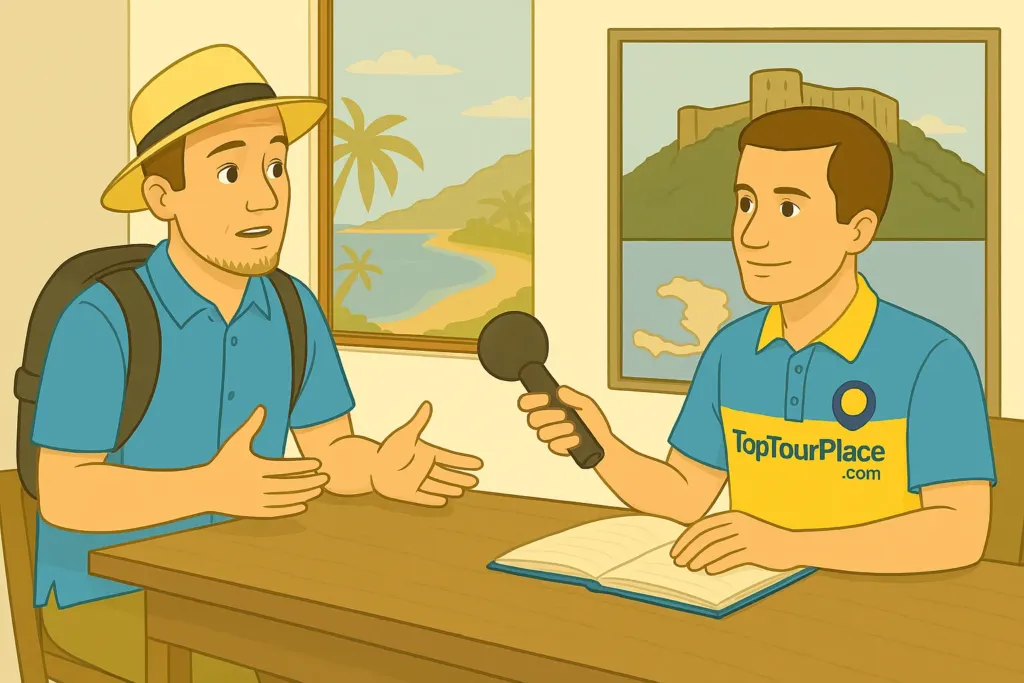We spoke with a European travel expert about when to go to Haiti, how to plan routes, safety and logistics, where to feel real culture and cuisine. Inside are honest tips, concrete places, and a story from Jacmel’s carnival that shows why people go at all.
TopTourPlace.com
: Who is Haiti for? Daredevils or the simply curious?
Marc Leblanc
: For the attentive. Haiti is not about checklists or all inclusive. It’s a place where context, respect, and flexibility matter. If you love living cities, crafts, music, conversations, and raw nature — it’s a match. But you need preparation.
TopTourPlace.com
: Where should preparation start?
Marc Leblanc
: With realistic expectations and a safety plan. Check up-to-date advisories, insurance, health: hepatitis A and typhoid shots, malaria prophylaxis if advised by your doctor. Work with a trusted local operator who knows neighborhoods and roads. And travel in daylight.
TopTourPlace.com
: Best time to go?
Marc Leblanc
: December to March brings the most comfortable weather. Summer is hotter, and June–November is hurricane season. For culture, aim for Jacmel’s carnival — a blaze of masks and music. Book early: quality rooms are limited.
TopTourPlace.com
: What should first-timers see?
Marc Leblanc
: In the north, the Citadelle Laferrière and Cap-Haïtien’s surrounds — powerful history and views. In the south, Jacmel: papier-mâché workshops, the seafront, a special light. For nature, the Bassin Bleu waterfalls. In the capital, it’s less about “sights” and more about meetings — artists, cooks, musicians — via reliable guides.
TopTourPlace.com
: How to get around?
Marc Leblanc
: Between cities, hire a private transfer with an experienced driver. Roads can be rough, signage sparse. Tap-taps are colorful and authentic but tricky and unsafe for newcomers. In cities, use prearranged taxis. Start early to be back before dark.
TopTourPlace.com
: Where to stay?
Marc Leblanc
: Boutique guesthouses and small hotels. In Jacmel — intimate seaside stays; in the north — historic guesthouses; in the mountains — eco-lodges. Note: power can be unstable; bring a power bank and patience. Choose properties with a proven reputation.
TopTourPlace.com
: Money and connectivity?
Marc Leblanc
: Cash is king: local gourdes and small USD bills. ATMs are rare and unreliable. For internet, get a local SIM/eSIM, but expect patchy coverage. Download offline maps and keep key addresses and contacts on paper.
TopTourPlace.com
: What food is unmissable?
Marc Leblanc
: Griot — crispy fried pork; tassot — dried, fried meat; diri kole ak pwa — rice with beans. Add pikliz — a fiery cabbage and pepper pickle. Drink local rum and mountain coffee. And always ask what the cook is proud of — that’s how you find the best plates.
TopTourPlace.com
: Safety rules you live by?
Marc Leblanc
: Minimize movements, pick clear routes, listen to your local coordinator. No flashy jewelry or gadgets. Ask before taking photos, especially of people and sensitive sites. Share your plan with someone, keep document copies. If the national situation is unstable, postpone — that’s okay.
TopTourPlace.com
: Is there room for spontaneity?
Marc Leblanc
: Yes — build it in. Leave half a day for a guided walk in Jacmel: your guide will open courtyards where masks dry and workshops tourists rarely see. Spontaneity shines when you have a solid base.
TopTourPlace.com
: A story that explains why Haiti is worth it?
Marc Leblanc
: Once in Jacmel, a downpour hit during carnival prep. We sheltered in a studio where three artisans were shaping masks — jaguars, birds, forest spirits. The elder sculptor smiled and said “poko fini” — not finished yet. He let me hold a wet mold, we pressed paper layers together, and he said: “A mask isn’t a face; it’s the story you want to show the world.” The rain eased, they poured strong coffee and took us to rehearsal — drums, dance, kids with shining eyes. At dawn he led us to Bassin Bleu: blue water, mist, first light. I realized Haiti is when beauty grows from bad weather, as long as people share their craft and time. That depth is the reason to go.
TopTourPlace.com
: Handy Creole phrases?
Marc Leblanc
: “Bonjou” — good morning; “Mèsi anpil” — thank you very much; “Tanpri” — please. Simple words open doors. Add a smile for a warmer welcome.
TopTourPlace.com
: Last, a short checklist?
Marc Leblanc
: Insurance, vaccines, a trusted local partner, daylight travel, offline maps, cash, power bank, light clothes plus rain shell, respect for people and time. And be ready to change plans — that’s part of traveling in Haiti.
TopTourPlace.com
: Thank you!
Marc Leblanc
: My pleasure. May your trip be mindful and full of meaningful encounters.
- Endemics of Baikal
- The Highest Settlements in the World: Life on the Roof of the Planet
- Birds
- Great lakes
- Moab
- Dance of Spirits in the Arctic Sky: The Northern Lights in Lofoten Island Mythology
- Pakistan
- Colombia
- Chile
- Indians
- Cod Wars
- Aztecs
- Island
- Africa
- Chechnya
- The Wettest Places on Earth: Where the Sky Almost Never Dries
- Global traveler risk ranking 2025
- Liberation of Belarus from the Nazis
- Bacalao – salted cod as a symbol of travel and the taste of Portugal
- 9 Reasons Why People Love to Travel to Other Countries











